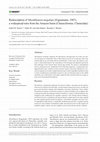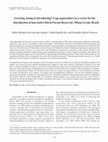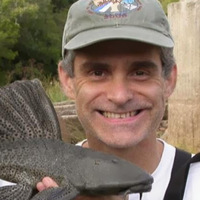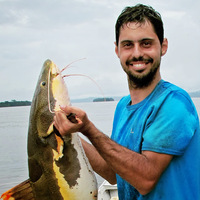Papers by Valter M. Azevedo-Santos

Moenkhausia currently comprises 90 valid species and represents one of the very species rich gene... more Moenkhausia currently comprises 90 valid species and represents one of the very species rich genera in Characidae. Most of these species need to be revised since their original descriptions are out-of-date and are uninformative. In this sense, Moenkhausia meg-alops is redescribed based on the examination of the holotype and additional specimens from drainages of the Amazon basin and the type locality. The species is distinguished from its congeners by the combination of the following characters: a conspicuous boot-shaped humeral spot, ventrally curved to anterior region of the body, followed by a second inconspicuous vertically elongated humeral spot; a dark longitudinal midlateral stripe on body extending from immediately posterior to the second humeral spot to the middle caudal-fin rays; a dark blotch on the upper caudal-fin lobe; and teeth with seven cusps on inner series of premaxilla and dentary. Resumo Moenkhausia compreende atualmente 90 espécies válidas e representa um dos gêneros mais ricos em espécies em Characidae. A maioria dessas espécies precisa ser revisada, por que as suas descrições originais estão defasadas e são pouco informativas. Neste sentido, Moenkhausia megalops é redescrita com base no exame do holótipo e de exemplares adi-cionais provenientes de drenagens da bacia Amazônica. A espécie é diferenciada das suas congêneres pela combinação dos seguintes caracteres: uma mancha umeral conspícua, em formato de bota, ventralmente curvada em direção à região anterior do corpo, seguida por uma segunda mancha umeral inconspícua, verticalmente alongada; uma faixa escu-ra longitudinal médio-lateral se estendendo imediatamente posterior à segunda mancha umeral aos raios medianos da nadadeira caudal; uma mancha escura no lobo superior da nadadeira caudal; e dentes com sete cúspides na série interna do pré-maxilar e dentário.
Here we extend a discussion initiated by Toussaint et al. (Sci Rep 6:22125, 2016) concerning the ... more Here we extend a discussion initiated by Toussaint et al. (Sci Rep 6:22125, 2016) concerning the relationship between global patterns of freshwater fish functional diversity (FD) and its vulnerability to human impacts. Based on a set of morphological traits, they concluded that Neotropical freshwater fishes have highest FD, but low vulnerability given high levels of functional redundancy. This conclusion implies that conservation efforts for freshwater fishes should emphasize temperate regions. This
A new species of the genus Moenkhausia is described from the Içá River, Amazon Basin. Moenkhausia... more A new species of the genus Moenkhausia is described from the Içá River, Amazon Basin. Moenkhausia britskii sp. n. is most similar to M. grandisquamis and M. xinguensis. From these two species it is readily distinguished by the pigmentation pattern of the humeral spot. Moenkhausia britskii further differs from M. xinguensis by the pattern of radii on the scales, which curve upward and downward (vs. scales with straight radii). Discussions on the putative relationship of the new species with M. grandisquamis and M. xinguensis, and on the peculiar upward and downward arched scale radii are provided.
A new species of the catfish genus Trichomycterus is described from tributaries of the upper rio ... more A new species of the catfish genus Trichomycterus is described from tributaries of the upper rio Grande, rio Paraná basin, southeastern Brazil. Trichomycterus pirabitira new species is diagnosed by the morphology of the metapterygoid and the caudal fin, and number of vertebrae, branchiostegal rays and interopercular odontodes, relative position of the dorsal, anal, and pelvic fins, head length, and body width. The new species seems to be closely related to the species of the T. brasiliensis complex by having the oblique arrangement of opercular odontodes described for the group.

Cage aquaculture has been developed in many countries, including Brazil. This form of production,... more Cage aquaculture has been developed in many countries, including Brazil. This form of production, although economically productive, may cause several impacts to the environment. Considering the historical relationship between aquaculture and species introduction, our study investigated the potential of cage aquaculture in spreading non-native species into hydroelectric reservoirs. We interviewed 19 fish farmers in Furnas Reservoir, Grande River basin. All producers have grown exclusively Nile tilapia (Oreochromis niloticus), an African fish, and all producers reported the occurrence of fish escapes. Releases were mainly accidental, but highly frequent during some management procedures, such as length classification, fish capture and juvenile stocking. Escapes were also reported due to cage damage and deliberate releases. These results indicate that, in cage aquaculture facilities, fish are frequently released to the external environment. When raising non-native species (e.g. Furnas Reservoir), these facilities constitute an important vector for fish introductions.







Uploads
Papers by Valter M. Azevedo-Santos